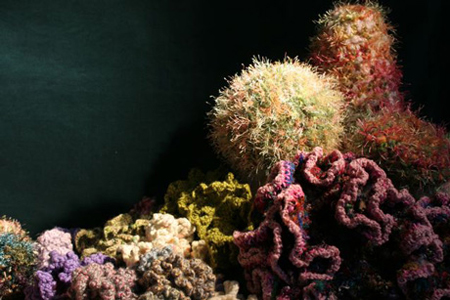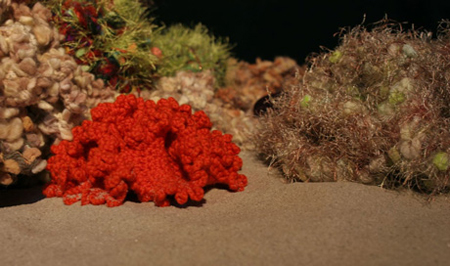Coral Crocheting
Christine and Margaret Wertheim
“Crochet Coral and Anemone Garden” with sea slug by Marianne Midelburg.
Photos by Alyssa Gorelick.
The Institute For Figuring is crocheting a coral reef: a woolly celebration of the intersection of higher geometry and feminine handicraft, and a testimony to the disappearing wonders of the marine world.
One of the acknowledged wonders of the natural world, the Great Barrier Reef stretches along the coast of Queensland like a psychadelic serpent, a riotous profusion of color and form unparalleled on our planet. But global warming and pollutants so threaten this fragile monster that scientists now believe the reef will be devastated in coming years. As a homage to the Great One, IFF co-directors Margaret and Christine Wertheim – who grew up in Queensland – have instigated a project to crochet a woolen reef. Using the techniques of hyperbolic crochet discovered by mathematician Dr. Daina Taimina in 1997, the Institute has been evolving a wide taxonomy of reef-life forms – loopy “kelps”, fringed “anemones”, and curlicued “corals.” While the process that brings these models into being is algorithmic, endless permutations of the underlying formulae result in a constantly surprising panoply of shapes. The quality of yarn, style of stitch and tightness of the crochet all affect the finished model so that each is as individual as a living organism. As a whole, the Crochet Reef is made up of various different “sub-reefs,” each with its own colors and styling: there is the Red Reef, the Blue Reef, the Bleached Reef, the Branched Anemone Garden, and our largest work, The Ladies’ Silurian Atoll, a ring-shaped installation with close to 1000 individual crochet forms made by dozens of contributors from around the world. In addition to these woolen sub-reefs is the massive Toxic Reef, crocheted from yarn and plastic trash.

